At the time of this writing, during the COVID-19 pandemic, gun shop traffic has evolved to stampede-level. Handguns are flying off the shelves whether practical choices or not. What are the practical handgun choices? Beyond that suitability concern, reliability should be a big priority. Simplified maintenance and availability of parts count heavily when normal supply channels turn to trickles. At that point, well-established designs become a blessing. They endure through proven track records (which also improve logistics).
by Steve Markwith, author of Handguns: A Buyer’s and Shooter’s Guide
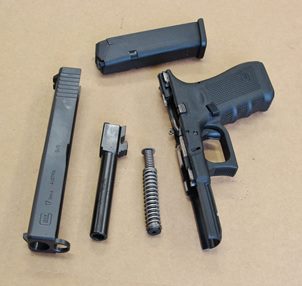
Right off the bat I can think of two entirely new pistol introductions from well-known manufacturers, both of which promptly flopped. Replacement magazines could already be gone, let alone key parts. A further concern for everyone is ammunition. Odds of locating at least some will improve through common calibers.
At the moment, 9mm is flying off shelves. But, that means it’s lurking out there somewhere; possibly available through bartering. And, as international supply lines tighten up, domestically manufactured firearms matter more.
These factors drove my list of five practical long guns; a shotgun, and several rifles. They led because of their suitability for both defense and subsistence. Odds are, some households already have at least one such firearm capable of meeting these needs. For others though, interest centers strictly on defense.
Either way, my practical handgun choices offer useful advantages. Beyond freeing up both hands, the proper choice can provide a constant means for protection, whether bedside, in the pursuit of hand sanitizer, or when far-removed from reinforcements. Given the cost of a gun and its necessary extras, one general purpose handgun could be best. But, that’s the wrinkle; individual needs vary and so do resources.
So, once again, consider my handgun list a menu. Pick and choose to best fit your circumstances. Like the previous picks, “household” guns (with possible shared use) factor in, including ambidextrous operation. The assumption here is a pre-existing level of competency, grounded in safety, with a means to control the handgun’s access. At that point, Priority One is it’s gotta work! Priority Two is it needs to carry well, so you’ll actually have it when you need it. Priority Three is adequate power balanced against control, for delivery of accurate shots. And, quite often, simple is better…
NUMBER ONE – A General-Purpose Handgun: Three Tactical Tupperware Options
A handgun that contains lots of rounds can be advantageous. Striker-fired, polymer-frame pistols include low cost and simplicity. Their consistent and manageable triggers are another attraction. By the way, “general-purpose” refers to service-type (think LE) pistols, which strike a practical balance of size, capacity and power. These make the top of many people’s list of practical handgun choices.
Calibers are typically 9mm, .40 S&W, or .45 ACP; all great picks. These pistols are often “open-carried” (OC), but sometimes a smaller-size gun could be better, especially if the main use involves concealed-carry (CCW). So, rather than list just one gun, three big names follow, each offering size-options based on well-proven designs.
These manufacturers also offer models with bilateral controls and some means to accommodate different hand sizes. Same story regarding the new wave of miniature red-dot sights (MRDS). Most incorporate accessory rails for use of lasers or lights. There are other good pistols like the excellent XD, etc., but these come from U.S. factories – something to consider at the moment. The cut-off caliber is 9mm.
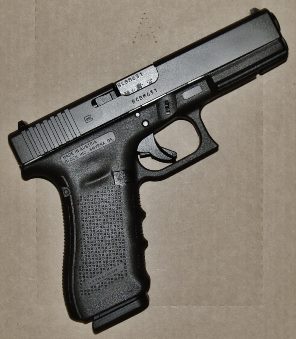
First up is Glock, which not only set the stage with their 17 +1 9mm G-17, but also created a tidal wave of polymer rivals. You still can’t go wrong with a Glock. It’s available in all of the popular calibers, and several distinct sizes, some of which are really small.
Grip inserts have also appeared. One great feature is, they all work the same way. Another is they’ll run for a very long time with just a modicum of care. True, the trigger must be pulled prior to disassembly, but that’s why we follow safety rules. Based on the proliferation of accessories, and recent copies, Glock’s popularity must now rival a 1911. Of course, there are other good choices…
Useful Glock combination: Interest in 9mm AR-15s is on the rise. Several good manufacturers now offer light, handy carbines that run off Glock magazines. Report, muzzle-flash, and recoil are minimal. Beyond home defense, a 9mm carbine can easily extend useful range to 100 yards.
During 2008, we switched to S&W 4 ¼” M&Ps, beginning with a mix of 175 pistols in .40 S&W and 9mm (long story), equipped with night-sights. At the time, interchangeable grip inserts were uncommon. This feature, combined with excellent ergonomics, solved fit issues and the M&Ps were an instant hit. Overall competency (including accuracy), dramatically improved.
Our 1st Gen guns also ran great from the beginning. The inventory soon expanded, but a decade later, we had pistols exceeding 20,000+ rounds. Although due for new pistols, the near-unanimous choice was, once again, an M&P. The latest 2.0s are even better. This time around ours are mostly 17 +1 9mms (thanks to better loads), with some 15 +1 Compacts in the mix. My similar 8 +1 Shield is even smaller, and my .380 Bodyguard is downright tiny, but they all have a familiar feel.
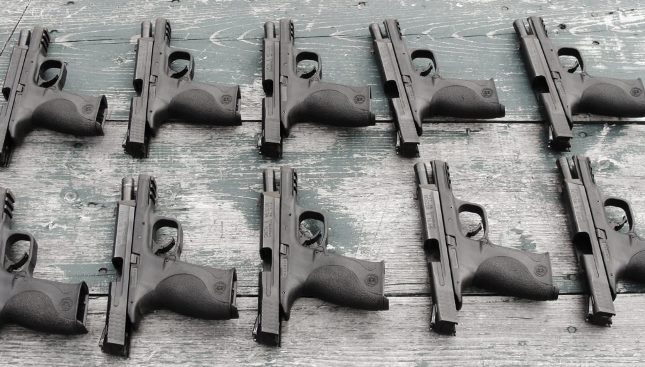
Meanwhile, even the U.S. military has jumped on the polymer bandwagon. Although relatively new, success of the Sig P320 is thus assured, with one million already in circulation. Ergonomics are good and the modular design permits easy reconfiguration via interchangeable grip shells. Beyond different sizes, users can “build” their own gun, including conversion to a compact version. If that’s not small enough, check out the P365 which, for me, feels close to perfect. If starting from scratch, I’d seriously consider these pistols.
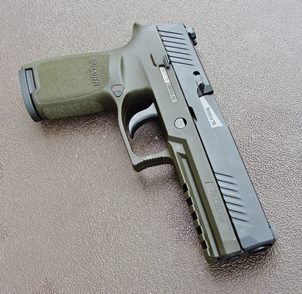
Advantages for all: Reasonable cost, manageable weight, simple operation, and a consistent trigger. Also, plenty of capacity depending on the model. Some folks buy two; a full-size GP type and a smaller CCW cousin. Others bridge this gap with one pistol (like the Shield), often in 9mm for better control.
Disadvantages for all: Although simple is good, the triggers serve as “safeties.” Drop one off a building and it probably won’t discharge. However, finger discipline is essential! Factor this into holsters and clothing, along with alternate carry methods. A fold of sweater in a trigger guard could produce extreme excitement. Same story for errant items in a purse or pack.
NUMBER TWO – A 1911 pistol
Many shooters are familiar this one. Otherwise known as the Government Model, it’s seen widespread use by civilians and U.S. military forces since 1911. Same for its standard cartridge, the .45 ACP. In this caliber, capacity is 7 +1, and it fires as a single-action. I captured my first 1911 (actually, a recapture), which had obvious signs of hard use. Nevertheless, it saved my hide several times and never failed to work.
The standard carry-mode is “cocked & locked;” external hammer fully rearward above a loaded chamber, with the safety-lever “on.” Despite its additional grip safety, this made LE administrators nervous; even during the widespread switch to semiautos in the 80s. Unlike the D/A pistols popular in that era (sparked by the new military D/A M-9 Beretta), a 1911 has no de-cocking lever. Thus, operation requires more attention. It’s probably a better choice for serious gun people who often carry nothing else.
Today, most formerly expensive custom features are now standard. Also, .45 ACP sales have decreased due to much-improved 9mm loads which also produce less recoil for improved control. This helps in 1911s smaller than standard 5” guns. The 4” or shorter types are increasingly popular, especially for CCW purposes. An exception is the resurgence of the potent 10mm, coupled with a 6” long-slide for maximum velocity. I’ve always had a soft spot for Government Models but, regrettably, I shoot M&Ps better.
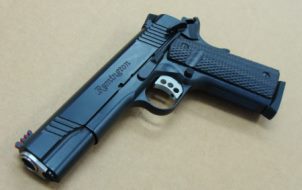
Advantages: A crisp and consistent trigger, good ergonomics, and proven reliability (for these reasons, 1911s are still a popular choice among competition shooters). Also, easy field maintenance, and tons of parts/accessories. 1911s are produced by most large handgun manufacturers in various sizes and calibers, from .22 LR through 10mm. The same frame is used for all of them (see below). It allows easy installation of aftermarket grips, including those with integral lasers.
Disadvantages: Lower capacity. Heavier empty than many fully loaded high-cap polymer pistols. Frames with rails for lights or lasers are even heavier (and may need a different holster). Requires some cautious attention, more so during carry, because of the cocked & locked design. During clearance, the thumb safety must be disengaged before a chambered round can be extracted.
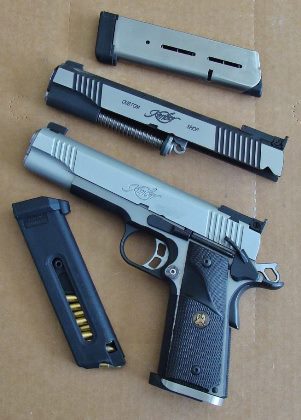
Caliber conversions: My .45 Kimber Eclipse often sports a Kimber .22 LR upper. It’s a simple conversion, requiring only .22-specific magazines. And, there are other possibilities: Using one different ejector, the standard frame can accommodate 10mm, .40 S&W, .357 Sig, .38 Super, or 9mm.
Starting with a complete 9mm 1911, you could exchange its entire slide-assembly for one in the above calibers (actually, some only require a new barrel, but zeros and springs factor in). Caliber-specific magazines are necessary, but that’s about it. Most people, including me, just buy separate pistols. But, this capability could resolve a caliber-specific ammo shortage.
NUMBER THREE – A Double-Action Revolver
A double-action revolver is one of the best practical handgun choices, and it could be just the ticket for outdoorsmen and some preppers. My go-to woods companion is a 4’ stainless, 6-shot, S&W Model 66, chambered for .357 Magnum. It’s weatherproof, totally self-contained, easy to load/unload, and carries well. Furthermore, it can fire two readily available calibers in three distinct power levels; .38 Special, .38 Special +P, and .357 Magnum.
The .357 is still a benchmark for so-called stopping power. With the right loads, it’s also enough for whitetails and black bear out to 50 yards or so. Meanwhile, relatively inexpensive and mild .38 Specials are perfect for small game or practice. Falling in between, .38 +Ps offer a viable defensive boost without much increase in recoil. Because the M-66 has adjustable sights, each load can be perfectly zeroed; important as range increases.
Our inventory of Model 65s (fixed-sight versions of the M-66) withstood two decades of constant use. Average round count was well above 50,000 rounds; primarily .38 Specials, along with some .38 +Ps, and just a few .357 Magnums. That’s the type of diet this medium-size K-frame was designed for. Those contemplating regular use of .357s can move up a few ounces to the sturdier L-frame, a truly elegant revolver! You can also add a small J-frame .38 Special for deep concealment. It will only offer 5 shots, but it’ll work the same way.
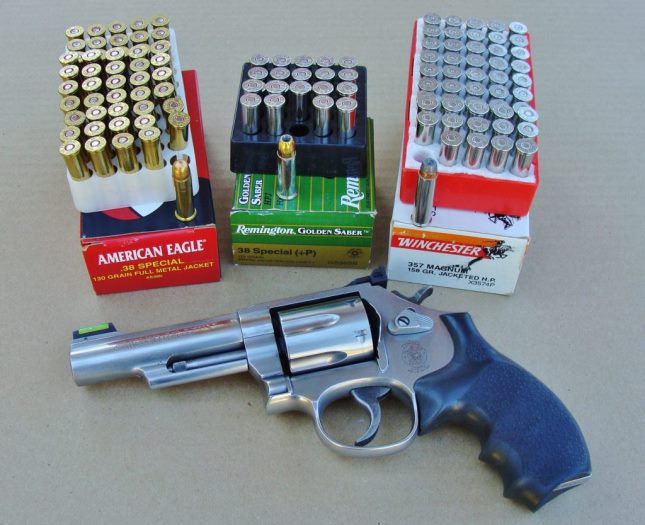
Advantages: Safe, simple, weatherproof, completely reliable, and extremely versatile. Eats about anything. Functions regardless of pressures. Fires two useful calibers which are often available during ammo shortages. Affords two useful trigger options; D/A for defense, and S/A for precise shots. Revolvers are usually accurate, too. The .357 Magnum loads provide extra punch and range. Add a set of Crimson Trace grips and you’ll gain a laser aiming system.
Disadvantages: Limited capacity and slower to reload than a pistol – in theory. Turns out, the right combination of speed-loaders and a well-practiced shooter can greatly close this gap – as proven during former joint handgun programs (I had my M-66 machined for ultra-quick moon-clips to the chagrin of some pistol shooters). Speaking of gaps, keep your digits away from the barrel/cylinder juncture, especially when firing .357s. No provision for a light. No LH offerings (easily surmountable through technique).
Useful combination: A .357 Magnum lever-action could be just the ticket for revolver owners. Beside sharing the same ammo, most hold a bunch, which can be dispensed with great rapidity. Another bonus: Rifle barrels typically boost .357 Magnum velocity by hundreds of feet per second. The newer solid-copper loads offer excellent expansion and deep penetration, good for larger game. And, of course, the lever-action is another completely self-contained system that’s legal everywhere.
NUMBER FOUR – A Companion Rimfire Handgun
This one’s more for practice and fun, or small game on the fly. Practice is even more meaningful with identical function, as evidenced by the recent appearance of Glock’s .22 LR model. S&W offers an M&P .22 LR (we use ‘em for remedial training). A rimfire Sig P320 is still pending but seems inevitable. Most 1911 .22 LR conversion units will slide right on a .45 ACP frame.
My small .22 LR S&W Model 63 is a frequent woods companion that works like my .357 M-66 (S&W sells larger rimfires built on that frame). Of course, there are plenty of good stand-alone rimfire handguns. Among the semiautos, Browning’s Buckmarks, the Rugers, and S&W Victories make good choices. Some even have threaded muzzles for suppressors.
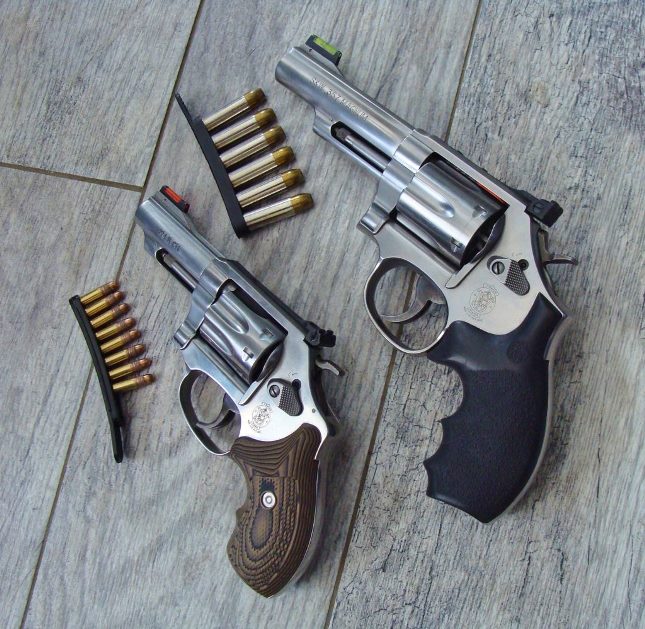
Advantages: Cheap shooting and relevant practice (with careful shopping). Minimal noise and recoil; helpful for curing a flinch. Handy for filling a campfire pot, or for close-range use against pests.
Disadvantages: Light for defensive purposes. Some use a .22 Magnum, but it loses steam in short barrels.
WORTHY MENTION – A Potato Cannon

Let’s face it, if the country completely tanks, you might need to skip practical handgun choices. What other uses will you have for hairspray and punky potatoes? Do a search of YouTube “Potato Gun Fails” before starting construction. And, no, it’s NOT a good shoulder-fired choice!
Advantages: Lends credence to circulating rumors that you own a cannon. Provides relief from reruns. Grow your own ammo.
Disadvantages: Serious risk of squandering edible rations unless fire-discipline is maintained.
PRACTICAL HANDGUN CHOICES SUMMARY
Plenty of good options exist, but covering them all is nearly impossible (even in book form). Instead, I went with well-respected guns and first-hand experience. Cost, too.
As mentioned in Starting a Survival Gun Collection, the actual price for the firearm is part of a greater “system-cost,” which often eludes budgeting. Some unforeseen items are actually essentials and many don’t come cheap. This accounts for the shotgun and revolver listings; two self-contained designs that require only minimal extras (no scopes, magazines, etc.). Add holsters, ammo-carriers, cleaning gear, lights, or other optics, and the cash-meter starts spinning. Not to mention two more key concerns…
First, don’t overlook responsible storage. A gun safe is highly worthwhile and a good one won’t be cheap. Some can get by with smaller locking containers, but cost is still involved.
Second, training is important, especially for new firearm owners. In fact, if you don’t fully understand how it works, leave it alone. Otherwise, guaranteed, all four of The Universal Firearm Safety Rules will be violated in short order. Don’t know what they are? Well, that makes the point.
We’re all in this together. Stay safe.
For way more information, read Steve’s book Handguns: A Buyer’s and Shooter’s Guide

2 comments
Nice write-up. I adore the SIG P320 series of pistols and prefer them to the other of the “Big Three” of striker-fired pistols – Glock and M&P. However, I sold me P320 and stuck with Glock due to magazine compatibility with my Windham Weaponry 9mm carbine.
Lake County Examiner: Lakeview, Oregon: Wednesday, March 24, 2021/Letters To The Editor
Best general-purpose handgun
For a general-purpose handgun consider Ruger’s SP-101 .357 Magnum revolver: “stainless steel”, 5 shot swing out cylinder (double-action), with 4.2” barrel and target sights for the citizen owning only one handgun. Versatile for “self-defense/house protection/concealed carry”, as a kit and trail gun for the outdoorsman/ sportsman, and for urban metro vs. wilderness rural use. At 30 oz. unloaded lightweight (for the hiker, backpacker, trapper), yet heavy enough to handle the .357 Magnum. Loaded with .38 Special 148 grain lead target wad-cutter ammo (next to a .22 or .32) practical for hunting small game: rabbit, squirrel, and grouse (for the campfire skillet), for dispatching vermin such as raccoon, skunk, possum, etc. Even for butchering livestock such as cattle with a head shot. Loaded with CCI’s classic .38 Special shot or snake load of No. 9 shot highly
effective in killing rattlesnakes. Readily and instantly accessible in reach via a nightstand, dresser or bureau drawer, or next to a sleeping bag inside a tent is very comforting armed security to have, especially at night!
This handgun would also be great for a long-haul trucker, or hay hauler, to carry. Even for the motorist traveling on a road trip. Yes, bear in mind being broken down, stranded, and having to spend the
night alone in your vehicle. This .38/.357 revolver combination along with an Atomic Beam Flashlight, survival knife, fresh drinking water, food, toilet paper, shovel, matches, wool blanket, etc. could certainly take back the night.
Even for a woman it’s smaller frame and size would still fit her smaller hands. And firing.38 Special ammo in this .*357 Magnum could still be handled by a female. Double action revolvers can be improved with aftermarket combat rubber grips. I recommend reading, “Meet Ruger’s SP-101 Revolver: The Ideal Gun For
Self Defense”, by Kyle Mizokan via the April 2019 issue of The National Interest.
James A. Farmer
Merrill, Oregon (Klamath County)
Long Live The State of Jefferson!
*.357 Magnum revolvers will chamber and fire .38 Special ammo, but not the reverse. Also….”SP-101 Like Physics, Only Practical” by Law Officer for January 3, 2009 is well worth reading.